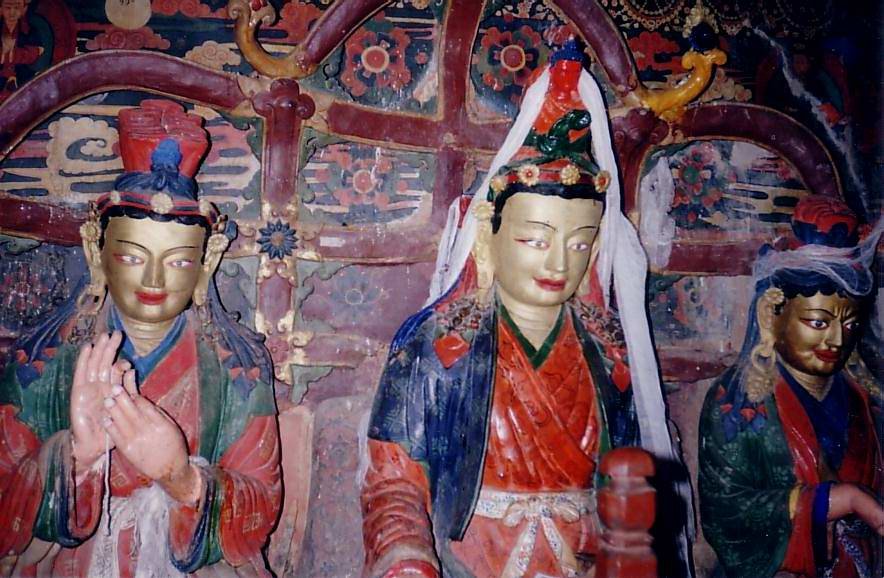
Semarkar (赛玛噶), the Daughter of Namri Songtsen, was a pivotal figure in the political landscape of 7th-century Tibet. Active between 633 and 650 AD, her marriage and intelligence-gathering efforts significantly influenced the relationship between the Tibetan Empire and the Kingdom of Zhangzhung.
1. Early Tibetan-Zhangzhung Marital Alliances
According to ancient Tibetan manuscripts discovered in Dunhuang, the Tibetan royal family had already established marital ties with Zhangzhung during the reign of Songtsen Gampo. This early alliance laid the foundation for Tibet’s eventual conquest of Zhangzhung. However, after Namri Songtsen’s death, Zhangzhung and other vassal states rebelled. When Songtsen Gampo ascended the throne as a young ruler, he launched a military campaign that reasserted Tibetan control over Zhangzhung. To solidify Tibetan dominance, he married his sister, Princess Semarkar, to the Zhangzhung King Likmegya. However, due to conflicts between Likmegya and the Tibetan princess, Songtsen Gampo eventually launched another military attack, fully subjugating Zhangzhung in 644 CE, three years after the arrival of Princess Wencheng in Tibet. As a result, Zhangzhung’s population was absorbed into the Tibetan administration.
2. A Strategic Marriage for Political Alliance
Semarkar’s marriage to Likmegya was a calculated political move orchestrated by the Tibetan court. This union aimed to strengthen ties between Tibet and Zhangzhung, ensuring stability and facilitating Tibet’s westward expansion. However, Likmegya’s affections lay with his beloved consort, Queen Xuge, leaving Semarkar in a vulnerable and isolated position at court.
3. A Princess Turned Intelligence Agent
Despite her secondary status in the Zhangzhung court, Semarkar played a crucial role as an informant for Tibet. She relayed critical intelligence regarding Zhangzhung’s military strategies, internal conflicts, and diplomatic stances. By embedding hidden messages in poetry and secret correspondences, she kept her brother, Songtsen Gampo, informed about Likmegya’s shifting loyalties and potential threats to Tibetan interests.
4. Influencing Tibet’s Military Strategy
Semarkar’s intelligence directly influenced Tibet’s strategic decisions. When she noticed changes in Likmegya’s attitude and detected his wavering allegiance, she alerted Songtsen Gampo, prompting Tibet to take preemptive military action. Her reports were instrumental in Tibet’s eventual conquest of Zhangzhung, bringing the region under Tibetan control and securing its position as a vassal state.
5. Geopolitical and Military Significance of Zhangzhung
Zhangzhung, also referred to in Chinese historical records as ‘Yangtong’ (羊同), covered a vast area, including the present-day Ali region of Tibet and parts of Ladakh. The Ce Fu Yuan Gui (册府元龟) states that the “Great Yangtong Kingdom” was located east of Tibet, west of “Little Yangtong,” and north of Khotan, spanning over a thousand miles with an army of 80,000–90,000 soldiers. Records from the Tang Hui Yao (唐会要) confirm that Yangtong sent tribute missions to the Tang dynasty in 631 and 641 CE but was ultimately conquered by Tibet by the end of the Zhenguan period (649 CE). The assimilation of Zhangzhung into Tibet was a crucial step in consolidating Tibetan rule over the western plateau.
6. Tibetan Governance Over Zhangzhung
Tibetan records from Dunhuang provide further insight into the governance of Zhangzhung under Tibetan rule. In 653 CE, the Tibetan emperor appointed Spug Gyem Rtsan Rma Chung as the governor (Mngan) of Zhangzhung. Over the following decades, Tibet used Zhangzhung as a military resource, drafting soldiers and collecting tributes. Despite Tibet’s firm grip, local rebellions persisted, such as the Zhangzhung uprising in 677 CE and later Tibetan-led conscriptions in 719 CE. Historical documents list Zhangzhung among Tibet’s regional administrative units, signifying its full integration into the empire by the 7th century.
7. A Lasting Legacy in Tibetan History
Semarkar’s legacy extends beyond her role as a political bride. She was a key figure in Tibet’s imperial expansion, demonstrating exceptional intelligence and resilience. Her actions not only facilitated the annexation of Zhangzhung but also cemented Tibet’s dominance in Central Asia. Her story, filled with sacrifice, strategy, and espionage, remains one of the most compelling episodes in Tibetan history.
Conclusion
Semarkar was far more than a princess—she was a strategist, a diplomat, and a spy whose contributions shaped Tibet’s imperial history. Her role in securing Zhangzhung as a Tibetan vassal state demonstrates the power of political marriages and intelligence in ancient diplomacy. Today, her legacy continues to be studied as a testament to the crucial role women played in Tibet’s rise as a regional power.

